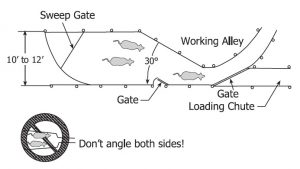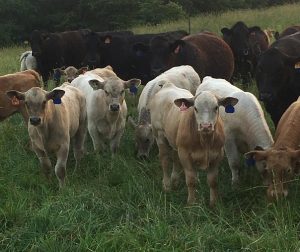Stan Smith, OSU Extension PA, Fairfield County
Frequently over the years we’ve talked about Ohio’s average cow herd size – between 16 and 17 cows at any given time – and how it impacts management and marketing decisions on that ‘average’ size beef farm. Related to that, recently I was asked, “What are the key beef herd management concerns Ohio’s small herd owners can address to compete with those who have the cow numbers that allows them to capture the advantages of economics of scale?”

Working facilities are a vital component for allowing small cow herds to compete with the economics of scale of larger herds.
As we think about what numbers it might take to capture the benefits of size and scale, keep in mind that most cattle travel to and from the feedlot in pot loads carrying 48,000 pounds of cattle. Also, the question of how smaller herds can compete on a scale with larger herds is not unique to just Ohio’s cattlemen. As we look to our neighbors we find the average cow herd size in Indiana is 16, Michigan’s average herd is 13.5 cows, West Virginia averages almost 19, Pennsylvania has an average of 12.5 cows per farm, and Kentucky has the most of any neighbors averaging 29 cows. Even when we look to Texas, we find their average cow herd size is 32. It’s obvious the challenges of competing economically with relatively small cow herds is not just a concern in Ohio. None of our neighbors’ average size herds have the capacity to ship a mixed sex, pot load of cattle themselves, much less a load of all steers or all heifers.
Since it appears much of the Midwest may be in essentially the same boat when it comes to average cow herd size, let’s explore a few of the options.
There are multiple solutions, and they come in a variety of management approaches. Many have been included in past Ohio Beef Schools as well as articles in the Ohio BEEF Cattle Letter over the years. In fact, some are addressed in this winter’s Beef School sessions. As an example, in his article from 4 years ago, Are You a ‘Committed’ Producer, John Grimes capsulized some of the opportunities that smaller producers might consider taking advantage of IF they have the facilities that allow it.

Working facilities allow for easier use of estrus synchronization, castration and even AI. That leads to the uniformity that even in small groups, leads to better marketing opportunities.
As mentioned in the article, facilities may be one of the biggest limiting factors that prevents cattlemen from capturing the benefits others may be taking advantage of. Those with less cattle to spread the cost of adequate handling facilities over sometimes fear they can’t afford facilities. As a result, they fail to take advantage of many of the management techniques that add value to calves in any size herd. IE: estrus synchronization, AI, preg checking, timely vaccinations, timely castrated and dehorned calves, etc. That said, the smaller herds may not be able to justify brand new ‘manufactured’ working facilities. Regardless, if trying to compete with the larger herds the first priority is to find a way to assemble some basic and affordable cattle handling facilities. We’re hearing more on this during the first session of this winter’s Ohio Beef School videos.
Facilities, alone, solve a number of the challenges in keeping up with larger herds. In fact, once they have facilities, the smaller herds may even have some advantages. Included might be the opportunity to reduce the number of high quality bulls needed by utilizing AI, and estrus synchronization programs will allow any size herd to maintain a much tighter calving season, thus having more similar size calves to manage and market each year.
As we’ve discussed many times, raising and properly managing replacement females is a challenge in a small herd. However, once the smaller herds commit themselves to purchasing bred replacements, they find they can use slightly higher birth weight, higher performing bulls that add enough pounds to the resulting calf crop to compensate for the need to purchase the replacements. Purchasing bred replacement females also lends itself nicely to managing a cross breeding program that results in higher performing calves. John Grimes expands on those thoughts in Why Do the Heifers Get to Decide Who Breeds the Cows?
Another ‘any size herd’ management opportunity cattlemen will hear during this winter’s two Ohio Beef School presentations is adding value to calves by weaning and backgrounding them on the farm before marketing them. This not only adds value by adding low cost pounds to the calves, but it also moves the marketing of the calves to a time when calf prices are traditionally higher. Last winter I detailed why that might happen in Key to Beef Cattle Profitability; Dare to be Different.
The annual market trends mentioned in the article linked above also lend themselves nicely to a Fall calving herd. This is a little ‘out there’ for some, but if a small Spring calving herd owner hooks up with a small Fall calving herd owner they can share one high quality bull that would end up covering twice as many cows annually. If the cattleman calving in the Fall can manage the feed situation, he/she captures huge benefits in the market place . . . Fall born calves ready for Spring grass always sell better than their Spring born siblings. In that regard, what you’ll find John Grimes shared on the subject of calving season some years ago in Improving Reproduction Management remains true today.
Frankly, there’s no magic bullet to compensate for the economics of scale, however, there are some things that become easier to manage and capitalize on in smaller herds. That list would likely include pasture management (especially if weaning calves on grass), artificial insemination (some small Ohio herds are 100% AI and don’t own a bull), estrus synchronization, weaning and backgrounding calves, and some of the other basic ‘value added’ strategies we’ve mentioned over the years.
Most of all, don’t miss the opportunity to see this winter’s Ohio Beef School video sessions. The thoughts shared in them regarding competitive advantage will work for all size herds.
For details about when the Ohio Beef School sessions and subsequent BQA training will be available in your area, visit the EVENTS/PROGRAM page of the OSU Beef Team website, or contact your local OSU Extension office.
Source: Ohio Beef Cattle Letter



Leave A Comment